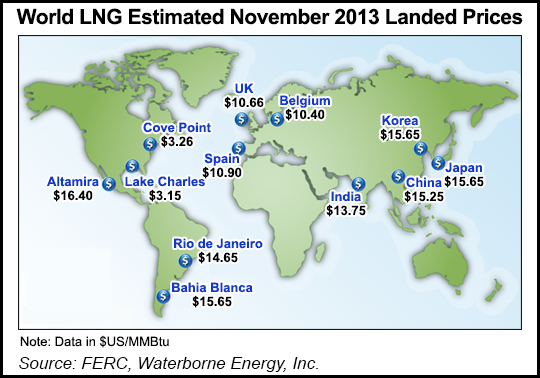Regulatory | LNG | NGI All News Access
BC Government Swears Off (for now) LNG Export Taxes
British Columbia’s (BC) government vowed Tuesday to ensure its embryo liquefied natural gas (LNG) industry grows up by refraining from taxes that weaken the competitive strength of Pacific coast export projects.

In the province’s 2014 budget Finance Minister Mike de Jong changed the Liberal administration’s tune. Re-election talk in 2013 of swiftly creaming a C$100 billion (US$91 billion) BC government “prosperity fund” off global LNG trade evaporated. De Jong emphasized that the LNG tax regime will reflect the industry’s ability to pay. Former talk of an export tax is gone. “Income tax” is the new official term.
“I don’t want to suggest a cascade of dollars flowing into the prosperity fund in the next five years,” the finance minister said.
Budget documents made it plain that he meant the first five years after the still-unknown time when any of the 10 proposals for BC coast LNG export terminal projects land overseas sales contracts that justify construction.
“We have not booked any revenue from an LNG income tax in the current three-year fiscal plan,” de Jong said, acknowledging that no industry participant has set any firm dates for building LNG facilities. “The tax dollars won’t start flowing until the first plant starts production.”
Final decisions on details, including rates, have been postponed until new legislation to implement the tax regime is introduced in the fall after more consultation with sponsors of export terminal plans, pipelines and northern BC shale gas supply development.
But even the government’s opening bid for export taxation calls for modest rates, held down in the single-digit range and to be applied in all cases only on a net-profit basis to plant revenues after operating expenses.
Until export terminal construction costs are recovered or for the first three years of plant operations, the finance ministry proposes to limit the tax rate to 1.5% of net revenues. After payout the rate would be set by a formula that takes gas prices into account and tops out at seven percent.
Under the proposed net-profit LNG tax rates, the provincial budget calculates that an export terminal loading tankers at a brisk pace of 1.5 Bcf/d would take 10 years — after construction costs are paid off — to generate C$1.4 billion ($1.3 billion) for the BC treasury.
The estimate does not include potential royalty revenues from government-owned shale gas deposits in northern BC that are the intended supply sources for the long lineup of Pacific coast LNG projects. Like the value of the proposed export terminal income tax, the outlook for royalties is highly uncertain and limited by an encouraging regime of levies only on after-expenses net profits.
De Jong, however, dismissed skepticism about the provincial Liberal government’s LNG and shale gas visions that has been expressed by observers from the opposition New Democratic Party to financial and industry analysts in the Canadian gas capital of Calgary.
“The skeptics are going to find it harder and harder over the coming years to deny that this is happening,” the BC finance minister said. “Seven companies already have their federal export licenses [from the National Energy Board]. Three more are in the application process. Two companies have entered into land agreements [for coastal terminal sites on government-owned property] with the province and a third…has just awarded an engineering, procurement and construction contract.”
De Jong’s budget further assured the gas industry that as final rates are set between now and autumn, “Global economic conditions and the supply of natural gas will be considered as we finalize the key components of the [export terminal] tax to ensure BC remains competitive.”
The BC government’s first LNG financial steps will be spending instead of revenue collection. De Jong’s budget includes C$9 million ($8.2 million) for project environmental assessments and C$65 million ($59.2 million) for environmental and economic development programs such as expanded training for plant construction and gas-field trades, including aid for native communities to participate as the industry evolves.
© 2024 Natural Gas Intelligence. All rights reserved.
ISSN © 1532-1231 | ISSN © 2577-9877 |
